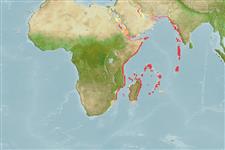Common names from other countries
>
Holocentriformes (Squirrelfishes, soldierfishes) >
Holocentridae (Squirrelfishes, soldierfishes) > Holocentrinae
Etymology: Sargocentron: Greek, sargos = sargus + Greek, kentron = sting (Ref. 45335); macrosquamis: Named for the large scales of the opercle (Ref. 27370).
Environment: milieu / climate zone / depth range / distribution range
Ecologia
marinhas associadas(os) a recifes; intervalo de profundidade 4 - 22 m (Ref. 27370). Tropical
Western Indian Ocean: Red Sea to Mozambique and the oceanic islands.
Tamanho / Peso / Idade
Maturity: Lm ? range ? - 4.7 cm
Max length : 9.0 cm TL macho/indeterminado; (Ref. 4201)
Descrição suscinta
Chaves de identificação | Morfologia | Morfometria
Espinhos dorsais (total) : 11; Raios dorsais (total) : 13 - 14; Espinhos anais: 4; Raios anais : 9 - 10. Body red with silvery reflections on many scales, shading to silvery white on lower part of the head, thorax, and anterior abdomen, scale edge light red; 5-6 oblique scale rows on cheek; body depth 2.3-2.7 in SL; head length (HL) 2.45-2.65 in SL; snout length 3.6-4.0 in HL; interorbital width 5.0-5.4 in HL; mouth terminal to slightly inferior; maxilla extending to a vertical at front edge of pupil or slightly before or beyond to it; upper jaw length 2.85-3.2 in HL; anterior end of nasal bone rounded; moderately large, spineless nasal fossa; upper surface of nasal bone between nasal fossa and edge of premaxillary groove with a retrorse spine; median edge of nasal bone with a retrorse spine and sometimes another anterior to it; preopercular spine 1.6-2.2 in orbit diameter, 4.75-6.4 in HL; spinules on posterior margin of preopercle 31 (on a 4.6 cm SL specimen) to 33-46 (6.25-6.85 cm); 3rd-5th dorsal spines subequal, the longest, 1.85-2.25 in HL; 3rd anal spine 1.45-1.75 in HL; broadly rounded caudal fin lobes (Ref. 27370)
Minimum depth reported taken from Ref. 30573.
Ciclo de vida ou comportamento de acasalamento
Maturities | Reprodução | Spawnings | Egg(s) | Fecundities | Larvas
Randall, J.E., 1998. Revision of the Indo-Pacific squirrelfishes (Beryciformes: Holocentridae: Holocentrinae) of the genus Sargocentron, with descriptions of four new species. Indo-Pac. Fish. (27):105 p. (Ref. 27370)
Status na Lista Vermelha da UICN (Ref. 130435)
CITES (Ref. 128078)
Not Evaluated
Ameaça para os humanos
Harmless
Uso pelos humanos
Ferramentas
Relatórios especiais
Baixar XML
Fontes da internet
Estimates based on models
Preferred temperature (Ref.
115969): 25.7 - 28.9, mean 27.5 (based on 467 cells).
Índice de diversidade filogenética (Ref.
82804): PD
50 = 0.5000 [Uniqueness, from 0.5 = low to 2.0 = high].
Bayesian length-weight: a=0.01622 (0.00774 - 0.03400), b=2.97 (2.80 - 3.14), in cm Total Length, based on LWR estimates for this Genus-body shape (Ref.
93245).
Nível Trófico (Ref.
69278): 3.4 ±0.4 se; based on size and trophs of closest relatives
Resiliência (Ref.
120179): Elevada, tempo mínimo de duplicação da população menor que 15 meses (Preliminary K or Fecundity.).
Fishing Vulnerability (Ref.
59153): Low vulnerability (10 of 100).
